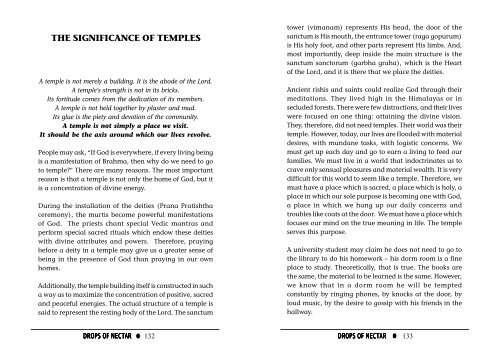Download - Mandhata Global
Download - Mandhata Global
Download - Mandhata Global
Create successful ePaper yourself
Turn your PDF publications into a flip-book with our unique Google optimized e-Paper software.
THE SIGNIFICANCE OF TEMPLES<br />
A temple is not merely a building. It is the abode of the Lord.<br />
A temple’s strength is not in its bricks.<br />
Its fortitude comes from the dedication of its members.<br />
A temple is not held together by plaster and mud.<br />
Its glue is the piety and devotion of the community.<br />
A temple is not simply a place we visit.<br />
It should be the axis around which our lives revolve.<br />
People may ask, “If God is everywhere, if every living being<br />
is a manifestation of Brahma, then why do we need to go<br />
to temple?” There are many reasons. The most important<br />
reason is that a temple is not only the home of God, but it<br />
is a concentration of divine energy.<br />
tower (vimanam) represents His head, the door of the<br />
sanctum is His mouth, the entrance tower (raga gopurum)<br />
is His holy foot, and other parts represent His limbs. And,<br />
most importantly, deep inside the main structure is the<br />
sanctum sanctorum (garbha graha), which is the Heart<br />
of the Lord, and it is there that we place the deities.<br />
Ancient rishis and saints could realize God through their<br />
meditations. They lived high in the Himalayas or in<br />
secluded forests. There were few distractions, and their lives<br />
were focused on one thing: attaining the divine vision.<br />
They, therefore, did not need temples. Their world was their<br />
temple. However, today, our lives are flooded with material<br />
desires, with mundane tasks, with logistic concerns. We<br />
must get up each day and go to earn a living to feed our<br />
families. We must live in a world that indoctrinates us to<br />
crave only sensual pleasures and material wealth. It is very<br />
difficult for this world to seem like a temple. Therefore, we<br />
must have a place which is sacred, a place which is holy, a<br />
place in which our sole purpose is becoming one with God,<br />
a place in which we hang up our daily concerns and<br />
troubles like coats at the door. We must have a place which<br />
focuses our mind on the true meaning in life. The temple<br />
serves this purpose.<br />
During the installation of the deities (Prana Pratishtha<br />
ceremony), the murtis become powerful manifestations<br />
of God. The priests chant special Vedic mantras and<br />
perform special sacred rituals which endow these deities<br />
with divine attributes and powers. Therefore, praying<br />
before a deity in a temple may give us a greater sense of<br />
A university student may claim he does not need to go to<br />
being in the presence of God than praying in our own<br />
the library to do his homework – his dorm room is a fine<br />
homes.<br />
place to study. Theoretically, that is true. The books are<br />
the same, the material to be learned is the same. However,<br />
Additionally, the temple building itself is constructed in such<br />
we know that in a dorm room he will be tempted<br />
a way as to maximize the concentration of positive, sacred<br />
constantly by ringing phones, by knocks at the door, by<br />
and peaceful energies. The actual structure of a temple is<br />
loud music, by the desire to gossip with his friends in the<br />
said to represent the resting body of the Lord. The sanctum<br />
hallway.<br />
DROPS DROPS OF OF OF NECTAR NECTAR NECTAR . 132 DROPS DROPS OF OF NECTAR NECTAR . 133

















